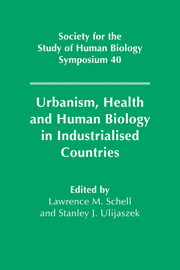Book contents
- Frontmatter
- Contents
- List of contributors
- Part I The urban environment
- Part II Epidemiology
- 5 Emerging infectious diseases: biology and behavior in the inner city
- 6 Fecundity and ovarian function in urban environments
- 7 Pollution and child health
- 8 Urbanism and health in industrialised Asia
- Part III Poverty and health
- Part IV Behavior and stress
- Part V The future
- Index
5 - Emerging infectious diseases: biology and behavior in the inner city
Published online by Cambridge University Press: 06 January 2010
- Frontmatter
- Contents
- List of contributors
- Part I The urban environment
- Part II Epidemiology
- 5 Emerging infectious diseases: biology and behavior in the inner city
- 6 Fecundity and ovarian function in urban environments
- 7 Pollution and child health
- 8 Urbanism and health in industrialised Asia
- Part III Poverty and health
- Part IV Behavior and stress
- Part V The future
- Index
Summary
Editors' introduction
In McMichael's account of urban change and modern development (chapter 2) infectious disease is seen to recede in importance as modern public health engineering and regulation reduced exposure to infectious agents in water and food, and the food supply itself became more plentiful and healthy. The recent rise of infectious diseases in urban settings is addressed by DiFerdinando who lucidly demonstrates changes in the frequency and distribution of the two most prominent infections, tuberculosis (TB) and human immunodeficiency virus (HIV). Changes in the frequency of these diseases are related to characteristics of urban populations, particularly urban social relations. Both diseases have been associated throughout their histories with urban populations, but during the emergence of HIV and the re-emergence of TB, each was originally associated with different social segments of urban populations. An important change occurred when interaction between the two segments increased. One of the themes expressed in several chapters of this volume is that urban populations inhabit overlapping microenvironments. In urban populations this overlap has changed the risk factors for the diseases, and changed the notion of their causes. One hundred years ago many urban residents were exposed to TB, and the presence of disease depended on variation in susceptibility rather than exposure. People defended themselves against infection, and the disease was caused by susceptibility.
- Type
- Chapter
- Information
- Publisher: Cambridge University PressPrint publication year: 1999



